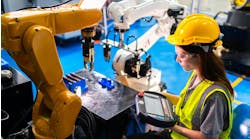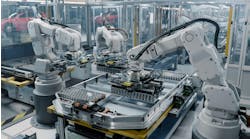Within three years, the world will witness a population explosion in industrial robots. According to the International Federation of Robotics (IFR), newly installed robots for industrial applications will surpass the 1.4 million mark by 2019. Only six U.S. cities have populations larger than that number, so how many jobs will be replaced as a result of this robotic expansion?
Comparing the number of robots to the number of people is a standard calculation to determine robotic density. The worldwide average is 66 units for every 10,000 employees. One of the geographic areas harboring a high robotic density is the European Union (EU), where 65% of the countries have a higher ratio of robots to employees than the global average. Are you with me so far? Or are you still trying to figure out what the six U.S. cities with the highest populations are?
While the robot saturation in Europe is fairly well-established, China is relatively low in robotic density, with only 36 units per 10,000 employees, but that’s largely due to the massive population there. In fact, its largest city, Shanghai, is home to more people than New York, Los Angeles, Chicago, Houston, Philadelphia and Phoenix—America’s six largest cities—combined.
There. Now you can stop thinking about it.
China is poised for an explosion in robot growth, with 40% of the world’s market volume predicted to be in China by 2019, according to IFR’s 2016 World Robotics Report. Make no mistake, China has its eye on quickly becoming one of the world’s top technological nations. And robots play a large part in that transformation, with China looking to increase the number of robotic units from 36 per 10,000 employees to 150 by 2020. That means an additional 650,000 new industrial robots—roughly the population of Memphis, Tennessee—will be installed throughout China. And what impact will those robots have on Chinese jobs? Will workers be engineered out and replaced by technology?
China might look for a prediction of what will happen in the fourth largest single market for industrial robots in the world. The United States installed 27,000 new industrial robots in 2015, a 17% increase. With a stable economic situation, North America, including Canada and Mexico, is expected to grow 5-10% from 2016 to 2019.
The United States’ significant role comes primarily from the automotive industry. American car makers rank third, behind only Japan and the Republic of Korea, in robotic density. The U.S. automotive industry has performed well of late, with 2015 marking its best performance in a decade.
Between 2010, when economies plummeted globally, and 2015, restructuring programs have been executed worldwide, and many of them involved installations of industrial robots. In the United States, Europe and Asia, 80,000 of them became operational over that period. That’s more than the population of Tuscaloosa, Alabama, but not quite the number of people living in Lawrence, Kansas.
Are we witnessing the loss of jobs that equal the populations of medium-sized cities as robots continue to multiply on factory floors? Consider what’s happened in the automotive industry. The IFR report indicates that employment in the automotive sector from 2010 to 2015 actually grew by 230,000. That’s enough jobs to employ every person in Baton Rouge, Louisiana. Laissez les robots rouler!
Also read: Are robots denser in China?
Mike Bacidore is the editor in chief for Control Design magazine. He is an award-winning columnist, earning a Gold Regional Award and a Silver National Award from the American Society of Business Publication Editors. Email him at [email protected].






